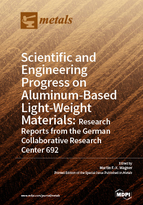Scientific and Engineering Progress on Aluminum-Based Light-Weight Materials: Research Reports from the German Collaborative Research Center 692
A special issue of Metals (ISSN 2075-4701).
Deadline for manuscript submissions: closed (15 December 2017) | Viewed by 76401
Special Issue Editor
Interests: mechanical behavior of structural and functional materials on all length scales; experimental and theoretical aspects of twinning; light metals; severe plastic deformation; ultrafine-grained microstructures; ultra-high strength steels; high strain rate testing
Special Issue Information
Dear Colleagues,
Academia and industry alike are faced with an ever-growing demand for energy-efficiency and reduced weights. Aluminum-based light-weight materials offer great potential for novel engineering applications, particularly when they are optimized to exhibit high strength and yet provide sufficient reliability. The last decade has thus seen substantial activity in the research fields of high-strength aluminum alloys and aluminum-based composite materials. For twelve years, backed by solid funding of the German Research Foundation (Deutsche Forschungsgemeinschaft, DFG), scientists of the Collaborative Research Center; High-strength aluminum-based light-weight materials for safety components (SFB 692) at TU Chemnitz, Germany, have contributed to this research area. Our research efforts have been focused on three main areas: ultrafine-grained aluminum alloys produced by severe plastic deformation; aluminum matrix composites; and aluminum-based composite materials (including material combinations like magnesium/aluminum or steel/aluminum and the corresponding joining and forming technologies). The framework of SFB 692 has served as a common basis for numerous scientific collaborations between scientists from the fields of materials science, design engineering, forming technology, production engineering, mechanics, and even economics in Chemnitz, and with many well-established international experts around the world. In this Special Issue of the well-established Metals journal, we intend to present recent results on high-strength aluminum-based light-weight materials that also provide a broad overview of the research activities in SFB 692 and beyond. While the Special Issue is primarily focused on work from the Research Center, we also welcome submissions from our collaborators and other experts in the field.
Prof. Dr. Martin F.-X. Wagner
Guest Editor
Manuscript Submission Information
Manuscripts should be submitted online at www.mdpi.com by registering and logging in to this website. Once you are registered, click here to go to the submission form. Manuscripts can be submitted until the deadline. All submissions that pass pre-check are peer-reviewed. Accepted papers will be published continuously in the journal (as soon as accepted) and will be listed together on the special issue website. Research articles, review articles as well as short communications are invited. For planned papers, a title and short abstract (about 100 words) can be sent to the Editorial Office for announcement on this website.
Submitted manuscripts should not have been published previously, nor be under consideration for publication elsewhere (except conference proceedings papers). All manuscripts are thoroughly refereed through a single-blind peer-review process. A guide for authors and other relevant information for submission of manuscripts is available on the Instructions for Authors page. Metals is an international peer-reviewed open access monthly journal published by MDPI.
Please visit the Instructions for Authors page before submitting a manuscript. The Article Processing Charge (APC) for publication in this open access journal is 2600 CHF (Swiss Francs). Submitted papers should be well formatted and use good English. Authors may use MDPI's English editing service prior to publication or during author revisions.
Keywords
- Light-weight materials
- Aluminum alloys
- Aluminum matrix composites
- Aluminum-magnesium composites
- Interfaces
- Severe plastic deformation
- Ultrafine-grained materials
- Equal-channel angular pressing
- Thermal stability
- Creep
- Precipitation
- Forming technology
- Materials science
- Surface engineering
- Mechanics and modeling






